Earliest meeting: Thursday 1st May 1701
Final meeting: Thursday 25th August 1870
Guildford, a large town in Surrey situated 27 miles south west of London, can trace its roots back to Saxon times. The earliest record of thoroughbred races taking place near the town, on Merrow Downs, was when the London Gazette of February 1701 advertised a 3 day meeting from Thursday 1st to Saturday 3rd May 1701. Horses for the meeting had to be shown at Guildford Town Hall at least two weeks before the event, and could either pay an 8 guineas entrance fee to Mr William Kent Goldsmith at the Unicorn in the Strand, or Mrs Lawford at the White Hart in Guildford. On the first day, Thursday 1st May 1701, the 80 Guineas Plate was won by Lord Thomas Millington, with other supporting Plates given by the Corporation, one for £25 and one for £10. Guildford became a royal meeting on Friday 2nd May when King William III attended and witnessed the £100 Plate go to Lord Halifax, while Mr Hall captured the lesser Galloway Plate. The meeting concluded on Saturday 3rd May when the Duke of Richmond won the main Plate. Meetings continued on an annual basis and in May 1718 a prestigious King’s Plate was held. The first occasion Baily’s Racing Register included results from races held in the town was from the Whit Tuesday meeting on Tuesday 3rd June 1727 when the principal race was His Majesty’s Plate over 4 miles which was claimed by Sampson, owned by Lord Halifax. The Historical List of Races of 1751 was undertaken by Reginald Heber following the death of John Cheney, who had initiated the project many years earlier, and he recorded a 4 day meeting being held at Guildford from Friday 28th May to Monday 31st May 1751. Lord Onslow sponsored a race which was won by Benjamin Rogers’s Garland, while the Third Hundred of Kings Guineas went to Shakespear (sic) owned by Mr Meredith. Meetings continued on a very regular basis for a further century and were always well supported by an impressive band of noblemen and gentlemen. On Monday 2nd July 1840 entries were accepted at the Railway Arms Hotel and none other than Lord Palmerston won the Queen’s Plate with his Priam filly.
The site of the former racecourse is now Guildford Golf course, although the former grandstand was on the south side of the course near to the 12th green but no longer exists. In 1717 George I stayed at Clandon House when he attended the races, sponsoring the King’s Plate.
Tuesday 3rd June 1727
His Majesty’s Plate for 100 Guineas over 4 miles
1. Sampson owned by Lord Halifax
2. Dotterell owned by Mr Greville
3. Creeping Kate owned by Mr Kitchenman
The King’s Plates, valued at 100 guineas, were a series of annual races which date from the time of Charles II and continued in some form or other up to 1887. From the publication of the first Racing Calendar in 1727 by John Cheny, up to 1751, the Plates were restricted to 6 year olds each carrying 12 stone and were run over three 4 mile heats. In 1751 they were staged at Guildford, Hambleton, Ipswich, Lewes, Lincoln, 3 at Newmarket, Nottingham, Winchester and York. After 1751 younger horses were permitted to run in King’s Plates, with 5 year olds allocated 10 stone and four year olds 9 stone.
The Racing Calendar of 1751 was undertaken by Reginald Heber following the death of John Cheney who had initiated the project many years earlier. He records that Guildford held a Four-Day meeting in May 1751, with race details shown below.
Duke of Kingston, Lord Grosvenor, Lord Baltimore, Lord Portmore, Sir J Moore, Sir M Featherstone, Sir Charles Bunbury, Sir John Shelley, Lord Grantley
Friday 28th May to Monday 31st May 1751
Third Hundred of Kings Guineas
1. Shakespear owned by Mr Meridith
2. Snail owned by Captain Hartley
Lord Onslow’s £50 Plate
1. Garland owned by Mr Benjamin Rogers
2. Little John owned by Mr Sparrow
3. Spider owned by Mr Been
1st to 3rd June 1762
Guildford Kings 100 Guineas over 4 miles
1. Leeds owned by Mr Wildman
2. Hackney owned by Sir J Moore
3. Kenton owned by Lord Grosvenor
Guildford Purse over 2 miles
1. Willing But Weak owned by Sir J Moore
2. Massinissa owned by Mr Churchill
3. Aristotle owned by Mr Bladon
The winner won both heats and carried the Darkest Green colours of Sir J Moore.
Cockfighting was held every day after racing and there is evidence from a bill of sale dated 1744 that the cockpit was on the site of the Red Lion Inn in Market Street. The cockpit was rented out for 15 guineas for race week.
At the meeting on 15th June 1764 the grey Gimcrack won at Guildford, eventually winning 26 out of his 36 races, and having the Gimcrack Stakes, run each August at York, named after him. On 5th June 1770 Eclipse, acclaimed the greatest racehorse of the 18th century, won at Guildford when, as a 6 year old, he carried 12 stone to victory. He was so named because on the day he was born, 1st April 1764, there was a total eclipse. In all he contested 18 races and won them all.
Tuesday 21st to Friday 24th May 1782
Guildford Gentlemen’s’ Purse over 2 miles
1. Young Pantalon owned by Sir J Shelley
2. Nephew owned by Sir Charles Bunbury
3. Cottager owned by Mr Compton
The winner’s colours were Purple with a Black cap; the second’s colours were Pink and White Stripes.
Guildford Members‘ Plate run over 4 miles
1. Ulysses owned by Sir Charles Bunbury
2. Britannia owned by Mr Shute
The winner wore Pink and White Stripes
Guildford Town Purse run over 2 miles
1. Catch owned by Mr Douglas
2. Standby owned by Mr Freeman
3. Clandon owned by Sir J Shelley
The winner wore Black with a White cap and the second wore Purple with a Black cap.
I am grateful to Ordnance Survey (© Crown Copyright) for permission to use the 1812 map shown below.
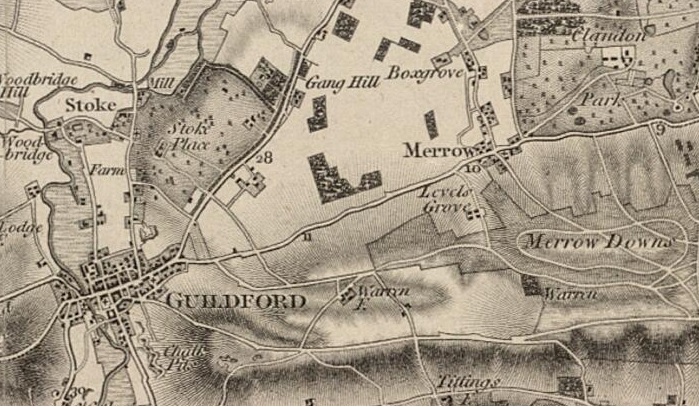
A more detailed map of the location of the racecourse is taken from an early 20th century newspaper and is shown courtesy of the Guildford Institute.
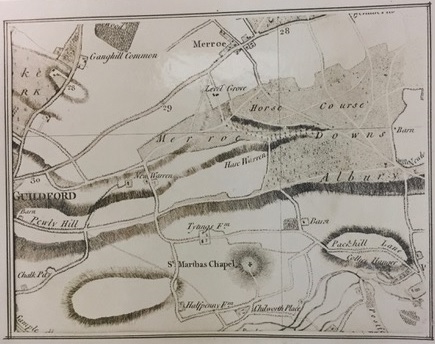
Wednesday 23rd and Friday 25th June 1824
Guildford ‘His Majesty’s Plate over 4 miles
1. Blunder owned by Mr T Scaith
2. Elfrid owned by Mr Wyndham
Guildford Town Plate over 2 miles
1. Unnamed filly by President owned by Mr D Page
2. Unnamed filly by Soothsayer owned by Mr Brown
3. Peggy owned by Mr Holbrook
Guildford Members Plate over 2 miles
1. Unnamed filly by President owned by Mr D Page
2. Gossoon owned by Mr Smith
3. Evergreen owned by Mr Cockburn
The racecard below is shown courtesy of the Guildford Institute and Richard Clarke. Results from the meeting are provided below.
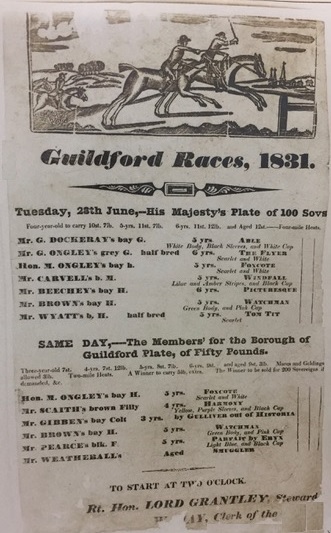
The 'mock' result card shown below provides results from the meeting held in June 1831. A racecard from that meeting still exists.
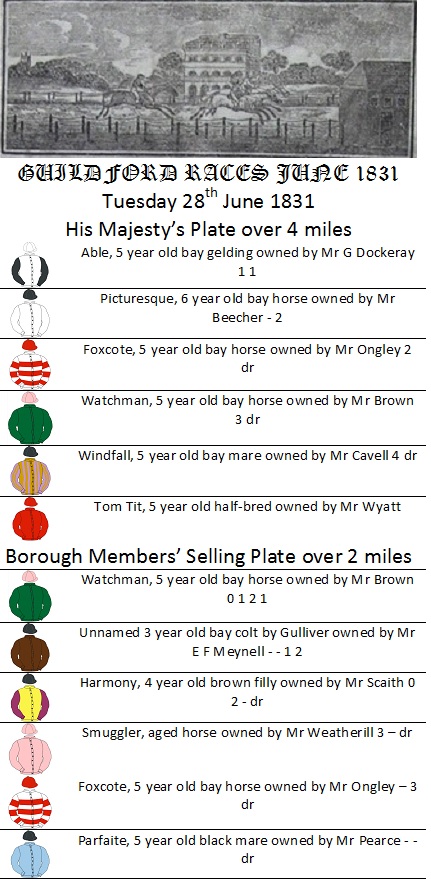
The rare 1838 racecard below is shown courtesy of Richard Clarke.
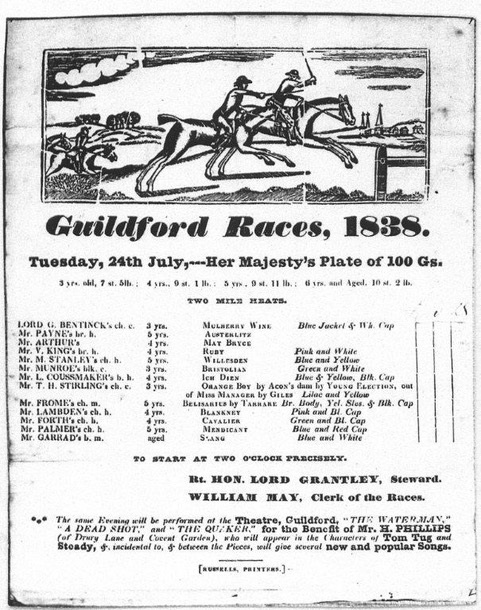
Tuesday 24th July 1838
His Majesty’s 100 Guineas Plate over 2 mile heats
1. Mulberry Wine, 3 year old chestnut colt owned by Lord George Bentinck – 1 1
2. Ruby, 4 year old brown colt owned by Mr V King 1 2 2
3. Mendicant, 5 year old chestnut horse owned by Mr Palmer 3 3 3
4. Blankney, 5 year old chestnut horse owned by Mr Lambden 2 dr
5. Austerlitz, 5 year old brown horse owned by Mr Payne – dr
6. Willesden, 5 year old chestnut horse owned by Mr W M Stanley – dr
7. Bristolian, 3 year old black colt owned by Mr Munroe – dr
8. Ich dien, 4 year old bay colt owned by Mr L Coussmaker - dr
9. Orange-Boy, 3 year old chestnut colt owned by Mr T H Stirling – dr
10. Tarrare, 5 year old chestnut mare owned by Mr Frome – dr
I am grateful to Richard Clarke for the photo of the Merrow village signpost which shows a racehorse, signifying its link with the former Guildford Racecourse.
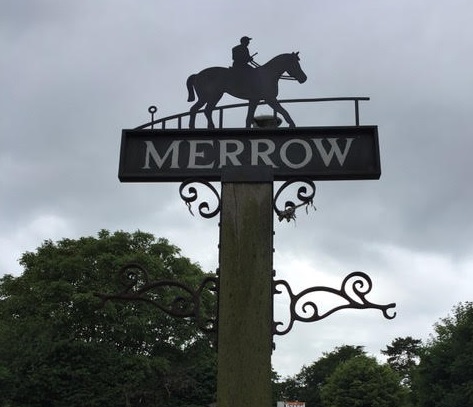
Today the old two mile racecourse on Morrow Downs has been turned into a thriving golf course. The site of the old grandstand is near to the 12th green.
Much of the information about this course has been found using internet research and is in the public domain. However, useful research sources have been:-
Northern Turf History Volumes 1-4 by J.Fairfax-Blakeborough
The Sporting Magazine
A Long Time Gone by Chris Pitt first published in 1996 ISBN 0 900599 89 8
Racing Calendars which were first published in 1727



